#PROTO hand tools
Explore tagged Tumblr posts
Text
PROTO hand tools offer precision and reliability for industrial and automotive needs. Crafted with durability and accuracy in mind, these tools are trusted by professionals worldwide. From wrenches to sockets, each tool is engineered to deliver exceptional performance, making PROTO the go-to choice for precision work in demanding environments.
0 notes
Text
The Finest Hand Tools For Every Task
In Today's Fast-Paced World, Where Efficiency And Precision Are Paramount, Having The Right Tools At Your Disposal Can Make All The Difference. Hand Tools Are Vital In Various Industries, From Construction And Automotive Repair To Woodworking And Metalworking. This Blog Post Will Analyze Three Renowned Brands Known For Their Exceptional Quality And Reliability: PROTO Hand Tools, Expert By FACOM Hand Tools, And Ingersoll Rand Tools. So, Let's Take A Closer Look At What Sets Them Apart And How They Can Enhance Your Workmanship.
PROTO Hand Tools: Precision And Durability In Every Detail
Professionals Have Trusted PROTO Hand Tools For Over A Century. The Brand Prides Itself On Its Commitment To Excellence, Consistently Delivering Top-Notch Tools That Withstand The Test Of Time. Whether You're A Mechanic, Plumber, Electrician, Or General Contractor, PROTO Offers A Comprehensive Range Of Tools Catering To Your Needs.
One Of The Key Features Of PROTO Hand Tools Is Their Exceptional Durability. Crafted From High-Quality Materials Such As Chrome Vanadium Steel, PROTO Tools Are Designed To Withstand Rigorous Use And Demanding Work Environments. The Brand's Commitment To Precision Engineering Ensures That Each Tool Meets The Highest Standards Of Accuracy, Providing You With Consistent And Reliable Performance.
Expert By FACOM Hand Tools: Unleash Your Expertise
Expert By FACOM Is Renowned For Its Exceptional Craftsmanship And Meticulous Attention To Detail. With A Strong Focus On Ergonomics And Functionality, Expert By FACOM Hand Tools Is Designed To Empower Professionals And Enhance Their Craft.
One Notable Aspect Of Expert By FACOM Hand Tools Is Their Innovative Design. The Brand Incorporates User Feedback And Extensive Research To Develop Tools That Offer Optimal Comfort And Efficiency. From Wrenches And Screwdrivers To Socket Sets And Pliers, Expert By FACOM's Extensive Product Line Covers A Wide Range Of Applications, Ensuring That Professionals Have The Right Tool For Any Task. Expert by FACOM Hand Tools
Ingersoll Rand Tools: Power And Performance
Ingersoll Rand Tools Is Synonymous With Power, Performance, And Innovation. With A Legacy Of Over A Century, The Brand Has Consistently Pushed The Boundaries Of Tool Engineering. Ingersoll Rand Tools Are Designed To Tackle The Toughest Challenges In The Construction, Manufacturing, And Automotive Industries.
What Sets Ingersoll Rand Tools Apart Is Their Relentless Pursuit Of Innovation. The Brand Consistently Introduces Cutting-Edge Technologies To Improve Productivity And Efficiency. From Impact Wrenches And Drills To Air Compressors And Pneumatic Tools, Ingersoll Rand Offers A Wide Array Of Tools That Deliver Unparalleled Performance And Reliability.
Conclusion:
Non Sparking Tools When It Comes To Hand Tools, PROTO, Expert By FACOM, And Ingersoll Rand Are Renowned Brands That Professionals Rely On For Their Exceptional Quality, Precision, And Durability. Whether You're A Seasoned Craftsman Or A DIY Enthusiast, Investing In Reliable Tools Is Crucial For Achieving Optimal Results.
#proto hand tools#expert by facom hand tools#stanley proto hand tool#work benches vices and workshop furniture#aerospace & rfid tool control#non sparking & sparkless tools#pneumatic impact tools dubai#impact and hand sockets dubai#ingersoll rand pneumatic solutions dubai#pneumatic impact tools port harcourt
0 notes
Note
Max I have a linguistics question. And I will even free your chess ask from purgatory as payment. So there's this thing that goes around saying that US English pronunciations are more similar to old English than British English. Is there any truth to this, and how would we know one way or the other?
There is some kernel of truth in it that is getting exaggerated or oversimplified.
Let me start off by answering, in a general sense, the question "how would we know one way or the other?"
The Part Where I Accidentally (on Purpose) Wrote a Brief Introduction to Historical Linguistics
Phonological change (change in the pronunciation of a language) doesn't work in the way we might naively expect it to. I think that most people imagine phonological change as basically happening by way of each word in the language taking a random walk through pronunciation-space as time goes along. Like genes in a genome, randomly mutating. This is not what happens. Rather, phonological change occurs via rewrite rules, which find-and-replace particular sequences of sounds in a systematic way across the entire lexicon. For example, such a rule might replace a [t] sound with an [s] sound whenever it precedes an [i] sound. This will occur in all words in the language at once, in a uniform way. These find-and-replace rules are called regular sound changes, and they pile up over time, constituting phonological change.
This fact—the regularity of sound change—is known as the Neogrammarian hypothesis.
The above picture is an oversimplification. There are a variety of exceptions and apparent-exceptions to the regularity of sound change, and dealing with them is one of the major challenges of historical linguistics. But as a model, the Neogrammarian hypothesis is extraordinarily powerful. It is literally what makes historical linguistics possible at all. The upshot of the Neogrammarian hypothesis is that when two languages are related, their vocabulary won't just be "kinda similar" in some nebulous sense, it will demonstrate systematic, predictable correspondences in sound between cognate vocabulary.
Here's an illustration of this, a comparative table of some cognates in Polynesian (from Wikipedia):
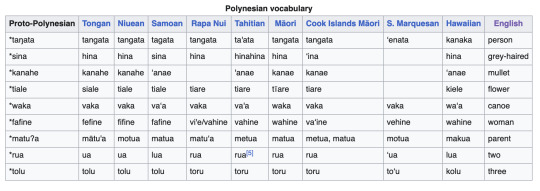
If you look at any two columns of this table, you'll start to notice correspondences. Tongan and Niuean /k/ correspond to Samoan /ʔ/ (a glottal stop, written with a apostrophe). This correspondence is one-to-one. Samoan /s/ corresponds to Tongan and Niuean /h/, but the reverse is not true: some instances of Tongan and Niuean /h/ correspond to Samoan ∅ (nothing). Tongan /s/, on the other hand, corresponds to Niuean and Samoan /t/, but only before /i/. Etc. etc.
These are systematic sound correspondences, born of Neogrammarian sound change from a common ancestor.
Ok, on the left hand side you will notice a column that says "Proto-Polynesian". The words in this column are all marked with *, indicating that they are reconstructed forms. They are linguists' best guess as to what the original, ancestral form of these words would have been in the Polynesian languages' common ancestor. There are various ways linguists make these reconstructions. First of all, we can do it by sheer majority rule: if most of the languages in a family reflect a sound as X, and only one or a few reflect it as Y, then (all else being equal and assuming the tree is flat) it is more likely that the original word had X. Almost all these languages have /t/ as the first sound in "person" (row 1), whereas Marquesan has /ʔ/ and Hawaiian has /k/. Thus the ancestral sound is reconstructed as /t/.
But there are other, more sophisticated tools that can be used. For instance, we know a certain amount about what sorts of sound changes are likely to occur and what sorts are not. Thus, for instance, an /s/ is reconstructed as the first sound in "grey haired" (row 2), even though the majority of languages have /h/. This is because we already know that s -> h is a fairly common sound change (and indeed corresponds to a known phonological process found presently in many languages—debuccalization), whereas h -> s is a much rarer change (in fact, I suspect wholly unattested), and corresponds to no known phonological process or phonetic explanation.
Finally, we can rule out reconstructions when the sound change needed to create them would not be a function. Consider, for instance, that the majority of the words in row 3 have no consonant sound at all before the final /e/. But the reconstruction features a consonant /h/ there. If we posit ∅ as initial instead, we have to come up with a sound change that explains how the /h/ got there. ∅ -> h doesn't work, because that would put /h/ everywhere! How about something like "∅ -> h between two vowels" (linguists would notate this change as ∅ -> h / V_V). That would work, but we see other instances of adjacent vowels (e.g. in row 4) with no /h/ between them, so that can't be it. Maybe "∅ -> h between /a/ and /e/" (∅ -> h / a_e). We can't rule this out on the basis of this chart, but we probably could by looking at more vocabulary.
And so on, and so forth. In general, we want to posit the simplest set of sound changes possible, in which the changes themselves are as probable as possible, in order to explain the data. These putative changes can then by checked against all sorts of outside observations, such as
descriptions of pronunciations in historical texts
past loanwords into languages whose phonological histories are already known with confidence
epigraphic data from archeology (not very applicable to Polynesian, unless we decipher rongorongo)
newly collected data from modern languages in the same family
evidence from rhyme schemes or alliteration schemes used in poetry composed in the past
etc.
to see if they hold up.
The Part Where I Answer Your Question
Ok, right. American English and "British English" (I assume this means Received Pronunciation) are two related language varieties. Thus, they share systematic sound correspondences, and we can try to reconstruct their common ancestor. Also the British Isles have produced an extraordinary number of texts in the past thousand years, including poetry and actual linguistic descriptions of various dialects at various points in time, which we can check these reconstructions against.
But actually you don't need most of that to identify a few ways in which (most) American English dialects are more conservative than Received Pronunciation. For one, Received Pronunciation has dropped /r/ at the end of a syllable (in English dialectological jargon it is "non-rhotic"), whereas General American English hasn't. There are some associated vowel changes too. One way or another, the /r/ is plainly original: elision of /r/ is more common and phonetically plausible than insertion of /r/ in a bunch of specific post-vocalic positions would be, /r/ is written in the orthography, historical descriptions of the language talk about an /r/ sound, etc. etc.
In other ways RP is more conservative. For example, GenAm has deleted /j/ (the "y" sound) in a specific phonological environment ([+coronal]_u) in words such as tube, GenAm /tuːb/, RP /tjuːb/.
Is "American English more conservative than RP" overall? I don't really think so. Certainly it has preserved a number of salient features that RP has lost, such as syllable-final /r/ and (in some dialects) /hw/ in words like what, and so on. But there's other senses in which RP is more conservative. And this is not even to mention the other dialects of Britain, which are manifold and much more diverse than the dialects of America. As to the strict question of the relative phonological conservatism of GenAm and RP, I think someone with more detailed knowledge of English historical phonological would have to come in and answer. Perhaps @yeli-renrong can comment.
705 notes
·
View notes
Text

Another possible link between Masamune and Jenova that occurred to me upon further brainstorming.
In ancient times, before the discovery of smelting, people forged weapons and tools from **meteoric iron**. Interestingly, there is a phenomenon known as telluric iron, derived from the Latin word for earth, "tellus," as seen in terms like "Telluric Fury" or "Telluric Scriptures."
According to the lore of the Ancients, Jenova, the Calamity from the Skies, landed on the Planet with a **meteor** impact. What if a meteor shard containing residual alien organics had fallen into the hands of the proto-Wutaians or Masamune the swordsmith? This piece could have broken off upon entering the atmosphere, landing near Wutai. Alternatively, as the Children of Men warred with the Cetra, it may have been a trophy taken from the Northern Crater or stolen from the Cetra in ancient times.
Could the sword itself contain a fragment of the meteor or meteoric iron that amplifies the effects of Jenova's DNA on the host? This would give additional meaning to the cryptic and ominous comment made by "Alissa Goldie," that the world would change as soon as Sephiroth takes the sword in his hands. She then gives a rather unsettling, knowing smirk after Angeal questions her supposed hunch.
#ffvii@luv fandoms#penumbra@theories#sephiroth#ff7#ffvii#jenova#alissa goldie#the first soldier#ffvii ever crisis#ffvii first soldier#ff7 ever crisis#ff7 first soldier
75 notes
·
View notes
Text
Guys I think should be in MOTU: Origins
My love of MOTU Origins is not very hidden, and they've hit tons of great points, but there's so much further to go. So, here's my rundown of what I'd want to see joint the MOTU Origins lineup.
Section 1: Give it the Sun-Man Treatment.
Blackstar
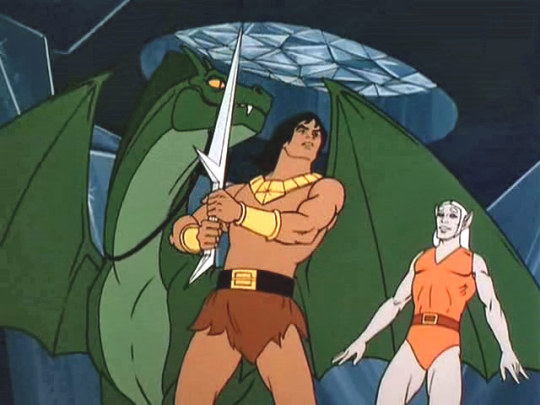
The proto-He-Man of yore, Blackstar as an IP is probably well within the price range for Mattel to sweep up to sprinkle into the line the same way Sun Man's universe was.
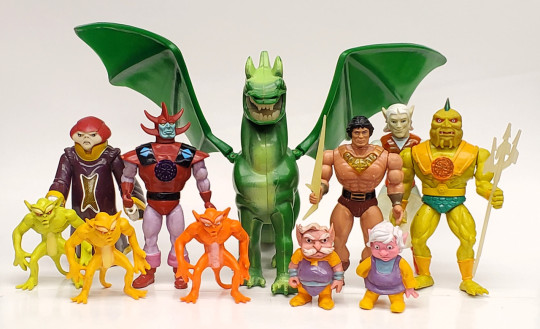

For advantages, it's VERY aesthetically compatible and has several strong character designs. It's no more obscure than Sun-Man, and I want hordes of those imp-demons, damnit.
BraveStarr
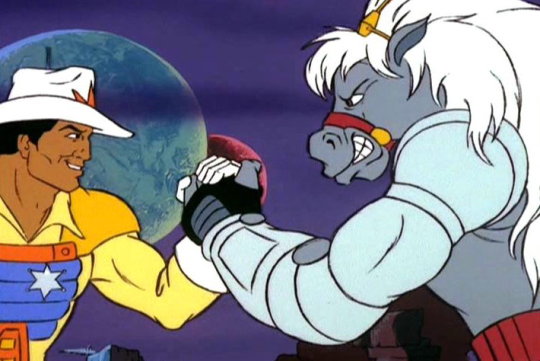
Again, a no-brainer. Find the character rights holders, get the rights. New Texas is out there in space, use it as an excuse to do MOTU:Origins versions of the New Adventures designs ("space travel" He-Man) and Rio-Blast. If they already own all the rights then them not having already done this is toyetic malpractice.

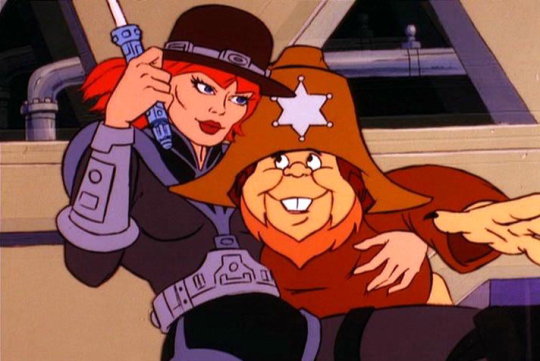
Advantages are obvious. BraveStarr rocks. You have a POC lead hero, Tex-Frickin'-Hex, and Thirty-Thirty, who would be well worth the extra tooling to make a deluxe figure of (you can always do an upgraded Stridor repaint). You would scatter them through waves to keep from overloading with the Space Cowboy thing, but def a winner.
Also, Rio-Blast. Rio-Blast, Yo.
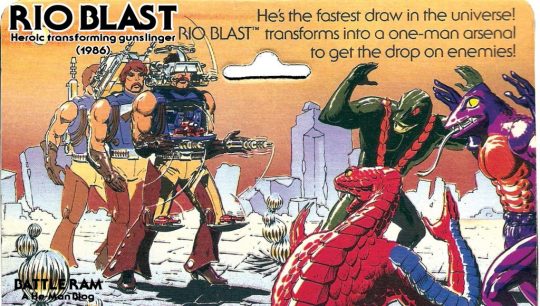
Skeleton Warriors
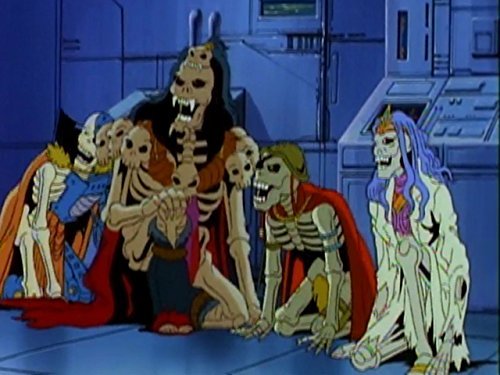
It was never strong enough to stand on its own. Give Skeletor some friends. 'Nuff Said.
One-Off Guest Stars
This section is a little different, as these wouldn't be permanent integrations, but more fun crossover one-offs rather than being a whole theme. Characters pulled from other Mattel-owned lines of the past:
Mojo Ken and Thunderpunch Barb-E


Here's the thing. This line is dead stupid, and should remain that way. Give Ken two heads (one 'bad' Mojo head and one 80s toy Ken style one) give Barbie weirdly plausible MOTU gear, the joke alone is worth the parts reuse. Best if nestled in with some Princess of Power characters.
Lets give Captain Power a hand, folks.

Its that live action TV show that interacted with the vehicles that landed in the uncanny valley between family TV and advert-traintment that never quite works!
Captain Power and Lord Dread are pretty much the only ones you'd want to hit, maybe the Soaron Sky Sentry. And really, they're not that hard to do. Captain Power could easily be made with Roboto legs and upper arms, any number of gloved hands, a new chest armor and a new head.
Any newly tooled pieces would be useful in MOTU movie and new adventure characters.
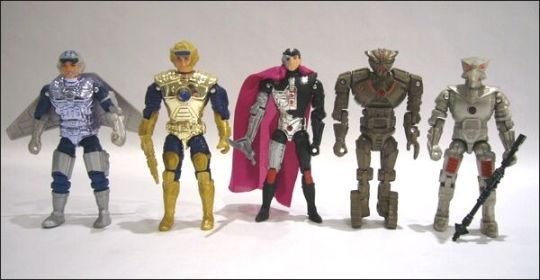
The Construx Alien demands your respect.

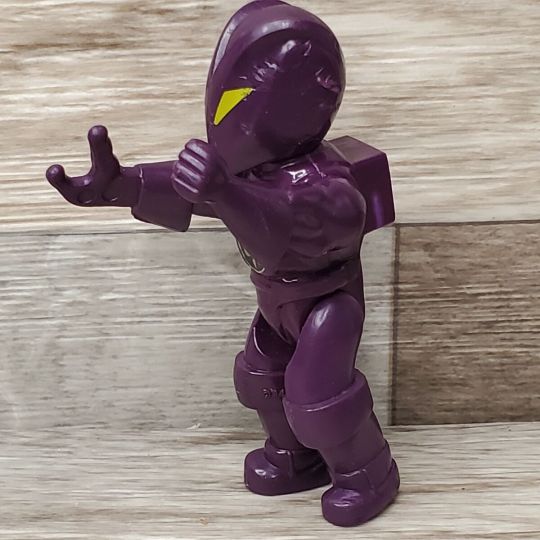
I know it makes no sense, I don't care, it's my list. He's amazing and needs to be big and buff with a weird hand.
Major Matt Mason has nothing better to do.
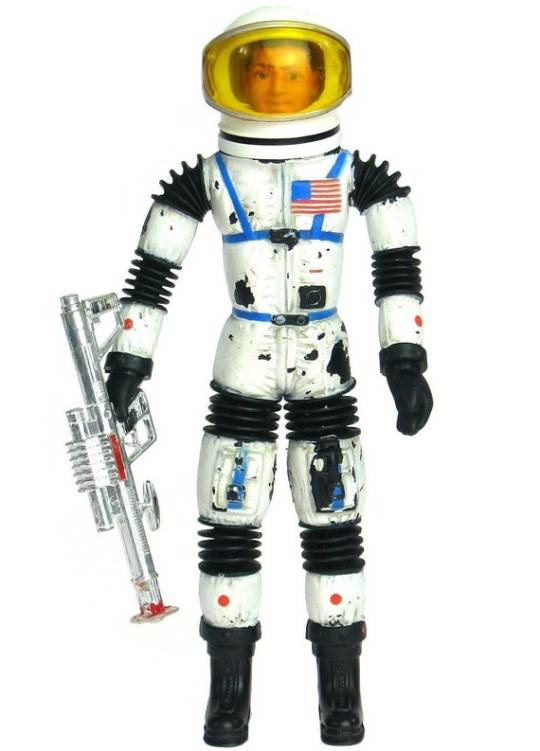

This set's a stretch, as it would require a chunk of new tooling, but again, maybe worth it for the New Adventures and She-Ra applications, plus hey, Astronaut prequel Biff Bestman, Evelyn Powers, and Captain Marlena parts!
He-Man's space-man friend is a role that could still be filled.
Next Up... Crossover Potential.
#my druthers#mattel#he-man#masters of the universe origins#motu#major matt mason#skeleton warriors#captain power#barbie#ken#bravestarr#blackstar
62 notes
·
View notes
Note
seems like for the qilik, obligate sophontry interrupted the transitional proto-avian glider stage and the hands are of some rationale trouble for an otherwise beak-using lineage. have you considered having the digit based tool use stem from increasingly dexterous handclaws to pry insects out of bark and tree trunks? i mean clinging to the side of trees is the general vibe of proto-avian gliders, and clades that focused on beak use for catching prey on the wing would continue into true avian lineages, while solidly gliding lineages focusing on digging for buggies woulda coulda shoulda be pushed by desertification/forest collapse occuring at geological speeds greater than that of evolutionary adaptation into terrestrial obligate sophontry. maybe. maybe they farmed termites or something. love the world hope they get that cow to the place :)
That's a really good idea, i think I'll go with it...
It fits perfectly with established lore of them having stemmed from climbing/gliding proto-birds (I haven't picked out a definite place in clade avelae (esp since the 'trees down' hypothesis of avian flight is contested) and there's some tremendous artistic license taken there, I've referenced microraptors and auorinis most for anatomy).
Also fits very well with established lore that they are predominantly insectivorous with populations outside of forested regions relying more heavily on vertebrate prey, and the fact that they have a pre-historic coevolutionary relationship with a species of ant, AND with the fact that their terrestrial lifestyle developed in response to fragmentation of forest habitats (separate to the 'contemporary' climate change event in the setting, which resulted in behaviorally modern qilik fragmenting into three distinct subspecies)
I'm thinking it would probably be the 'thumb' digit that is most specialized into tearing bark (as a better excuse for opposability lol) while the other two digits remain strong and flexible with curved claws to grip bark and assist with tearing. A flexible 'thumb' used to extract insects from bark could give way to more specialized tool use than could be accomplished with the mouth (probably stripped twigs to 'fish' for ants/termites in a similar fashion to chimps).
Their tool use probably predated this adaptation, ancestral gliding qilik may have been corvid-like in intelligence, but more dexterous manipulating limbs would allow for refinement in tool use and reinforce the ''hand''s dominance as a manipulating limb over the beak. And this would be further reinforced by a more terrestrial lifestyle.
As it stands their wing and hand anatomy is like this with great diversity in extent of feathering, given their flight feathers are vestigial in all three subspecies, which themselves are highly hybridized (flight feathers are most retained in only the most genetically isolated populations that dwell in forests and cliffs, where they are used for wing assisted incline running and to slow falls (though no anatomically modern qilik are capable of actual gliding)).
Sloppy as hell ref image
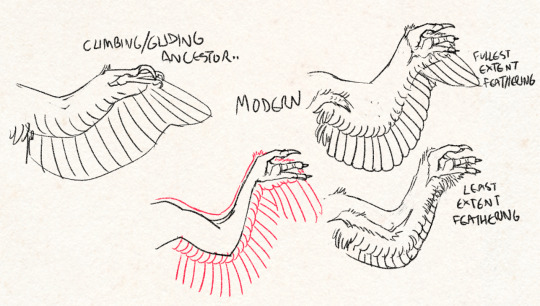
They have lost their curved gripping claws on their 'fingers' but retain a shorter version of the probing claw on their 'thumb'. I definitely need to refine the anatomy here but it's a start
61 notes
·
View notes
Text
by Seth J. Frantzman
In retrospect, it’s important to look at UNRWA as an organization that was created to thwart the establishment of Israel. The UN approved the Partition Plan for British Mandate Palestine in 1947. Israel declared independence in 1948.
UNRWA was then established and took a significant portion of the Palestinian population under its wing, effectively becoming a state within a state.
Because Egypt and Jordan had taken over the areas of the Arab state that were supposed to be established based on the Partition Plan, UNRWA stepped in as a kind of state in the making for Palestinians. Most people don’t view UNRWA as a proto-state, but in essence, that is what it has become.
UNRWA camps served as the foundation for the majority of Palestinian political – and, later, militant and terrorist – activities. Schools and refugee camps organized spaces for the groups that emerged, ranging from Fatah to the PFLP to Hamas.
For instance, Hamas gained power partly through areas in Gaza, such as Khan Yunis, from which killed leader Yahya Sinwar hailed. Many other refugee camps also became known as bases of various groups and gunmen.
UNRWA would prefer not to take responsibility for the fact that its camps became the main organizing ground for gunmen and terrorism. In fact, the rejection of Israel’s existence comes primarily from the UNRWA camps.
What that means is that the UNRWA state or empire was organized to destroy Israel and use the refugees as the main engine of this destruction. For decades, the number of refugees has grown, and their political aspirations have shifted from supporting two states to supporting one state. October 7 was an outgrowth of this shift.
The concept of UNRWA is to keep Palestinians dependent, living in refugee camps generation after generation, while using its young men as foot soldiers to fight Israel.Winding down the camps and having the people live normal lives and believe in two states and peace could have potentially resulted in peace. However, the UNRWA mandate was never to embrace peace, two states, and coexistence.
One can draw a direct line from the end of the Second World War and the end of the Holocaust to the establishment of the State of Israel and the creation of UNRWA as a weapon in the hands of the international community to try to undermine Israel and use refugees as proxies against Israel.
This line is clear because the UN played a key role in the Partition Plan. The UN then undermined its own plan by creating UNRWA, which served to perpetuate the conflict.Each succeeding generation has taken up the baton from the UNRWA camps and launched wars against Israel. The first war occurred in the 1950s, when Egypt used “infiltrators” and fedayeen (guerrillas) against Israel.
Then there was the Jordanian Civil War, aka Black September, in the 1970s. The war then moved to Lebanon, where Palestinians upended the Lebanese system, leading to Israel’s invasion in 1982.
Then the movement moved via Tunisia back to Gaza and the West Bank and laid the groundwork for the First Intifada. When the Oslo peace deal emerged, Hamas emerged to upend it.
Since the 1990s, the UNRWA camps have not embraced two states or peace but have instead continued to embrace extremism, thereby becoming a hotbed for radicalism.The road to October 7 was paved from there. In Gaza, when Hamas took over, UNRWA didn’t oppose Hamas but was available to partner with it.
Now, Gaza has been destroyed in another war because of UNRWA’s unwillingness to end this conflict and stop using refugees as a tool against Israel.
#unrwa#isreal#hamas#gaza#west bank#united nations#palestinians#refugees#refugee camps#partition plan#war against israel
31 notes
·
View notes
Text
(Note: this is all totally non-rigorous free association)
Famously, the King James Version of the Bible translates Exodus 22:18 as "thou shalt not suffer a witch to live." This is one of those translations, though, that has suffered for passing through multiple different cultural lenses over the textual history of Exodus. Alternate modern translations say things like "put to death any woman who does evil magic," "*wizards* thou shalt not suffer to live," or even "whoever has sexual relations with an animal must be put to death."
In the Septuagint, the underlying word is translated φάρμακος; despite the connotation of the English word, a masculine noun; the word is associated with magical arts in general, but is *especially* associated with poison. It's from φάρμακον, a word which can mean either "poison" or "drug," and is the origin of "pharmacy." Greek had a rich vocabulary for the supernatural: an older and more general word seems to be γοητεία, "charm, jugglery, sorcery," from γόης, "sorcerer, wizard, juggler, cheat." That it includes in its semantic field the concept of sleight-of-hand shows that mundane deception is countenanced as a possible explanation for claims of magical power, which no doubt contributes to the dim social reception of magic, but also shows a neat symmetry with the modern concept of the stage magician, whom we publicly acknowledge as really being just a particular kind of illusionist and entertainer. Another Greek word for magic is, well, μάγος, the source of the English word, ultimately a borrowing from Old Persian maguš. A maguš was simply a priest of Mazda in the old Zoroastrian religion; the word is of uncertain etymology, but its connotations in Greek arise from crediting a Greek mythical version of Zoroaster with the invention of magic and astrology, showing us that perhaps orientalism of one sort or another has long been part of European traditions of the occult. There is also θαυματουργία, "wonder-working, doing miracles, wizardry."
But the Septuagint word choice is an odd one; as I understand it, the actual underlying lexical item is מְכ��שֵּׁפָה/mekhashefah, the feminine form of מְכַשֵּׁף/mekhashef. The root of this word seems to be כשף/KH-SH-F, which has been glossed various ways. One gloss I find particularly interesting is "cut." Kenneth Kitchen links this etymology to the cutting of herbs; thus, a mekhashef is a kind of herbalist, and the context, as with pharmakos, is the fear of poisons--the feminine form might also make sense here, as it seems plausible that just as in our modern society, poisoning was a more reliable tool for killing for women than for men, for whom the possibility of physically overpowering their enemies was less likely.
But I think it's interesting to note other ways in which magic is about division and breaking. Though in modern fantasy a "warlock" is either just a generic wicked sorcerer, or a summoner of demons, the word comes from Old English wǣrloga ("promise-deceiver"), a deceiver, a breaker of oaths. A warlock is thus someone who dissolves social ties, or even betrays their baptismal vows by making an unholy vow, an un-promise, to Satan himself. The English "witch" comes from the Old English wiċċa or wiċċe (masculine and feminine forms respectively), from Proto-Germanic *wikkô, "sorcerer, necromancer," from the verb *wikkōną, "to practice sorcery." One likely derivation of *wikkōną is the Proto-Indo-European stem *weyk-, "to separate, to divide, to choose." This may be a reference to cleromancy, the casting of lots; many ancient words for magic link together fortunetelling of various kinds (the second element in words like "necromancy" and "cleromancy" is ancient Greek μᾰντείᾱ, "divination, prophecy, fortune-telling), but here again the concept of separation appears in a way that is difficult to ignore.
The Romans, like the Greeks, looked east for their wisdom, and were also obsessed with divination in particular, so their words for magic are often borrowed from Greek, or concern forms of fortune-telling in particular: haruspicina, the inspection of entrails; the genius or numen, language of spiritual presence and will (the latter not dissimilar to the mana of Polynesia); auspicium, the interpretation of omens, especially the flights of birds. Perhaps other kinds of magic invoked skepticism: Pliny argues that, except possibly in the making of potions (the Romans, no less than the Greeks and the Hebrews, knew that the right herbs could kill!), most claims of magic were simply lies--though there was little harm in apotropaic wards to set the mind at ease. Apuleius granted the existence of spirits and demons, and both Augustus and Constantine worried enough about magic to try to suppress its practice.
In Sanskrit, magic was apparently sometimes called इन्द्रजाल/indrajala, "Indra's net," a metaphor for emptiness, a word that foregrounds the idea of fraud and illusion. Similarly, the word माया/maya means "magic," but also "illusion," being in that way akin to the English notion of glamour found in fairy-stories. There is also possibly semantic overlap with German Zauber, whose meaning is "magic," but which is etymologically connected to Old English tēafor, "to paint [a picture]," and Icelandic töfrar, "enchantment." (Icelandic also has galdur, "sorcery," but also "[conjuring] trick.") Chinese offers the root 魔/mo2, which according to Wiktionary is from Sanskrit मार/mara, "death, pestilence;" in Chinese it takes on theurgic qualities: "devil, demon, magic, the unnatural, crazy," depending on the context it's found in: 魔羅, a kind of Buddhist demon; 魔術, "magic," as in an illusion imitating the supernatural; 瘋魔, "to be insane, to be fascinated by, to be enchanted by," a concept of obsessive madness shared in other cultures, including our own.
A full cross-cultural, historical comparison of words pertaining to magic is far beyond my capabilities, of course; but exploring current in the vocabulary and historical development of words around magic is interesting so far as it peels back the thick systematizing, empirical layer within our culture and helps us glimpse how these ideas functioned in the past. Nowadays, magic is often prototypically the magic of high fantasy: it is systematic, little more than a flashy kind of science, even if it is one accessed through mental discipline rather than mechanical instruments. Magic is patterned, stable, fundamentally knowable, because we are so thoroughly grounded in systems of knowledge that understand the whole world as patterned and knowable that we cannot imagine anything else. We redefine magic in ways that simplify it down to nothing: to be little more than abstract spiritual practice, moral therapeutic deism with countercultural window-dressing, or to mean nothing more than simply acting on the world. But is that really in keeping with the spirit of the thing, as it is has been imagined for most of history?
Magic is about many things. It is about division: discrimination, separation, cutting. Cutting the body of the sacrifice, to prod at its bloody insides; cutting breath from a living victim; cutting off the sacred from the unholy, and vice-versa. It is about speaking, chanting, singing, the form and the performance of words. It is about writing (itself a word which means to cut or carve into something). It is about deception: lies in pursuit of status or money, lies to avoid culpability for murder, lies about secret knowledge. It is about feeling oneself inhabiting a world filled with intentional beings, beings with a will and nature unknown and perhaps unknowable to you. Spirits of the dead, of the air, and of the wild world; the genius loci, the demon, the hungry ghost. It of a world when the night could claim real darkness, when the stars were forever an inscrutable mystery, and when the terrifying unknown could intrude into your life at a moment's notice. Even modern occultism feels like a nonsensical imitation of the past, with emphasis on benign enlightenment or spiritual growth, when ancient magic was rife with murder, curses, treachery, and simple human greed. The huckster fortune-teller, who cynically defrauds their customrs, is closer to the spirit of magic than the observant neo-pagan.
We are mostly too sure of ourselves, and too confident in our ability to understand even that which is at first horrifying and inexplicable, to really replicate the feeling of that kind of magic. A world in which that kind of magic is possible is a world in which the last few centuries of philosophy and epistemology and science are shown to be so profoundly wrong that we are left with nothing but naive superstition and fear. Or else, it is a world where all these basic forms of inquiry that we take for granted simply do not work--because if they did work, we would be back in our own comforting, familiar world, a world of rationalism and enlightenment, albeit perhaps with a few of the phenomenological incidentals changed. I wonder if it is really possibly anymore for us to tell stories in the mode of that older world. With the exception of certain kinds of horror, I don't really know of anything that comes close.
561 notes
·
View notes
Text
In honor of Tron Day, here's my project for my Tron OC Ark that I've been working on or a while now!
I used this base with some modifications to it for everything:
Iyzel Reaar's F2U Female Ref Base
The main modifications I did were to mirror half of it so I didn't have to figure out how to draw the circuits twice, erase certain features I'm not sure Basic programs have, and make the lines solid.
I used Windows 11 Paint's line and shape tools to draw the circuits, with adding a few pixels here and there when needed.
I used the GNU Image Manipulation Program for a lot of the color editing I did and for layering the textures.
-
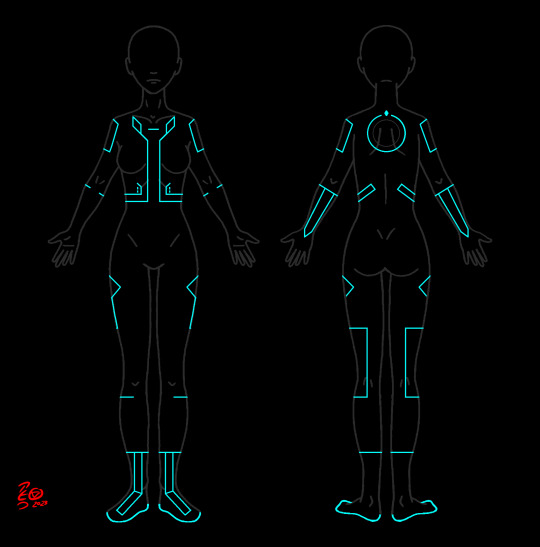
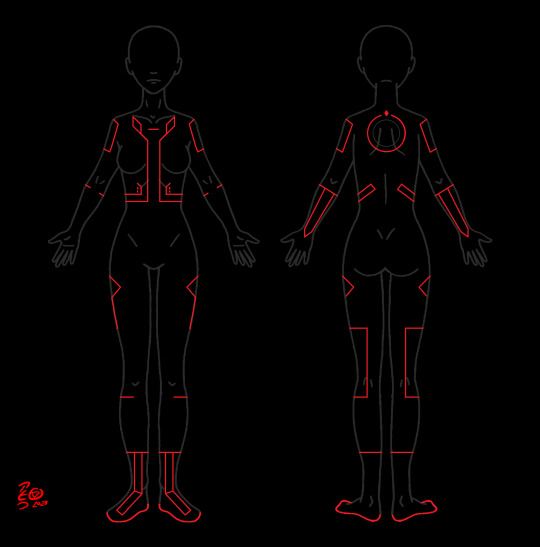
The first two are Ark's base circuits, along with the red rectified version of them for Mars.
I used my friend @quesadillawizard's art and design for Ark - Ark's circuits are based off ones from the DS version of Evolution and Wolfy added more features to them.
I used the reference he made for me to make the circuits and referenced this sketch as well.
-


The next two are the Tron/Renegade circuits from Uprising, in both gray and black, as seen in the show.
@tucatalog was super helpful for references!
I mainly used two posts of theirs:
I looked at a few others as well, but I have a list of 50+ of their posts and were flipping between them, so I'm not entirely sure which others I used.
-
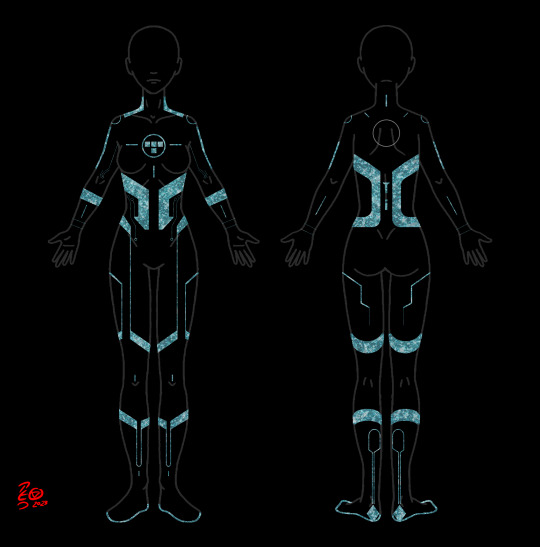

The next two are Grid scar versions of the Tron/Renegade circuits.
In Ark's backstory, she was captured and tortured by the Occupation. I've played around with different scar configurations for her and I love the idea of them literally carving the Tron circuits out/off of her.
I decided to do a little something different for the scars, I've tried another technique that wasn't much fun, and I'm not sure how to mimic the scars from Uprising.
So, I took some textures I got from Etsy and layered them over each other to try to make something interesting.
Textures I used:
Gemstone Crush
Iridescent Textures
Glassy Textures
Iridescent Glass
Sparkly Glitter
Fake Glitter Particles
I'm not sure if most of these came through, I figured out the glitter ones did a lot of the heavy lifting I wanted, so they're the most visible ones and the ones on top.
Anyway, one is just the Renegade scars and the other is the scars overlaid on Ark's circuits.
-
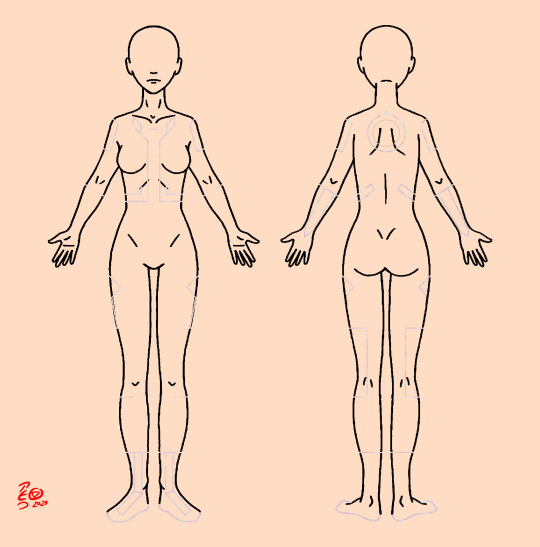

The last two are the circuits and scars over a skintone for circumstances when Ark ends up in the User world.
I like the thought of program circuits being barely visible in the User world, with just a hint of faint iridescence when the light hits them just right.
One of the textures from this pack fit my idea fairly well, so that's what I used:
Iridescent Textures
The scars are the ones I made earlier with a skin tone color overlay to make them blend in.
This is what I started this project for, as I wanted a visual for an RP and a potential fic.
-
I've done a smaller scale version of this before, that time I made the scars by repeatedly scribbling over the circuits with multiple different colors, which hurt my hand, lol:
-
Anyway, that's my project! It's not perfect, but I'm pretty pleased with how it came out!
A big thanks to @quesadillawizard and @proto-actual for looking them over!
Happy Tron Day!
#Tron#Tron Legacy#Tron Uprising#Renegade#Tron OC#Ark#Tron: Legacy#Tron: Uprising#OC#OCs#idea bag#my art
31 notes
·
View notes
Text
RATHGAMES
hey yall! just added community copies for all my games that were falling behind on em, and figured it'd be a good time to go over everything ive released so far!
KATABASIS: after your death, you wash ashore in a sunless, brutalist afterlife. use your emotional baggage from life as weapons and tools as you explore this tangled purgatory and try to find a way to escape.
DISPARATEUM: there are an infinite number of worlds in the Disparateum, and the Named City connects them all. explore a city where museum hallways turn into fractal labyrinths, where outdoor markets are held in dreams, where stories are ruled by a council of dragons, where your internet connection is routed through a giant spider, where mirrors hide cruel secrets.
BXLLET: bullets are precious in the apocalypse, despite everyone's efforts to move on from them. with one bullet, you can decide who lives and who dies. with five, you can unlock strange and alien powers. with twenty, you can rule the world, or wipe it out again.
(ive also got RXLOAD, a love letter to all the fantastic BXLLET supplements written since the game's release, and DXMON, a collaboration with Jon East to adapt BXLLET's mechanics for a Chainsaw Man-inspired setting)
CHARCUTERIE: three zines, each about 40 pages long, each with a heaping handful of small games, writings, doodles, and other projects.
ive also got some smaller projects under the break!
STATIONKEEPING: a small index card game for carrying around in your back pocket. slowly repair a space station as you live your life, and occasionally meet friendly aliens or connect your station to someone else's.
NOT WEAVERDICE: a super small Worm proto-ttrpg. i feel like rigid, strictly-defined point-buy power systems go against the strange, flexible, deeply unfair powersets present in Worm, so i made a short guide to making strange, flexible, deeply unfair powersets fun to play with.
MORTAL POPBAT: a 600-page funko pop wargame. build your army and brutally wipe out your enemy's POP!batants. if you actually play this, let me know so i can point and laugh.
WINTERGREEN: a ttrpg campaign that fits entirely in a mint tin. help a small frigid community in a series of short, interconnected quests.
42 notes
·
View notes
Text
Unlock Precision with Proto Hand Tools: A Toolbox Essential

In the realm of craftsmanship, having the proper equipment at your disposal is paramount. Proto Hand Tools stand as a beacon of excellence, imparting unparalleled precision and sturdiness to increase your work to new heights.
Precision Redefined
Proto Hand Tools are crafted with meticulous interest in detail, embodying the essence of precision. From wrenches to screwdrivers, every device is engineered to supply correct results, making every venture a seamless endeavor. Whether you are an expert tradesperson or a DIY enthusiast, Proto Hand Tools redefines precision in the toolbox.
Durability Beyond Compare
A toolbox essential should not only be precise but also endure the rigors of demanding tasks. Proto Hand Tools boast a strong design, constructed with high-quality substances to face up to the test of time. From heavy-duty construction sites to difficult domestic projects, this equipment ensures durability and reliability.
Versatility Unleashed
Proto Hand Tools offers a comprehensive range, catering to diverse needs and applications. Whether it’s automotive repairs, carpentry, or general maintenance, Proto provides a versatile toolkit. Embrace the flexibility these tools afford, allowing you to tackle various projects with confidence and ease.
Invest in Excellence
Choosing Proto Hand Tools is an investment in excellence. Elevate your craft by way of incorporating this equipment into your toolbox, experiencing the ideal combo of precision, durability, and versatility. Embrace excellence, and let Proto Hand Tools end up your depended-on companions in the pursuit of the most reliable craftsmanship.
0 notes
Text
Facom Tools: Unleashing Expertise And Precision In Every Application
In the vast realm of tools and equipment, FACOM is a beacon of excellence and innovation. With a rich heritage spanning several decades, FACOM has consistently delivered cutting-edge solutions to meet the evolving needs of professionals across industries. This blog post explores the world of Facom Tools, highlighting their exceptional quality, unparalleled performance, and diverse products.
Ingersoll Rand Tools: A Collaboration of Excellence
As a testament to FACOM's commitment to excellence, their collaboration with Ingersoll Rand Tools has resulted in a synergy that sets new standards in the industry. Ingersoll Rand Tools, known for their exceptional power and durability, have seamlessly integrated with FACOM's precision engineering, offering users a comprehensive range of tools that are second to none. The union of these two industry giants ensures a winning combination of reliability and performance for professionals worldwide.
Non-Sparking Tools: Safety Meets Efficiency
In hazardous work environments where sparks can pose a significant risk, FACOM Tools' range of non-sparking tools proves to be a game-changer. These specially designed tools are crafted from materials that prevent sparks, ensuring workers' safety and the integrity of the workspace. Whether in industries such as oil and gas, chemical, or mining, FACOM's Non Sparking Tools provide peace of mind without compromising efficiency or precision.
Expert by FACOM Hand Tools: Unleashing Precision
FACOM's Expert line of hand tools represents the pinnacle of precision engineering. Crafted with meticulous attention to detail, Expert By Facom Tools offer accuracy, ergonomic design, and durability. From wrenches and screwdrivers to pliers and hammers, each tool in the Expert range undergoes rigorous testing and quality control to ensure it meets the highest standards. Professionals across industries rely on Expert by FACOM hand tools to deliver consistent performance in every task.
FACOM Tools: A Complete Toolbox for Professionals
FACOM's commitment to providing comprehensive solutions is evident in its extensive range of tools. From socket sets and torque wrenches to tool storage systems and workshop equipment, FACOM offers a complete toolbox for professionals. Their products are designed to enhance productivity, improve efficiency, and withstand the rigours of demanding work environments. With FACOM Tools, professionals can rely on a brand combining innovation, expertise, and longevity to meet their needs.
ConclusionFACOM Tools continue to set the benchmark for excellence in the industry, consistently delivering top-quality products that professionals trust. Whether it's the collaboration with Ingersoll Rand, the innovation behind non-sparking tools, the precision of Expert by FACOM hand tools, or the extensive range of offerings, FACOM is synonymous with reliability and performance. Professionals across industries can confidently rely on FACOM Tools to tackle every task with precision, efficiency, and unmatched durability.
#proto hand tools#expert by facom hand tools#stanley proto hand tool#work benches vices and workshop furniture#aerospace & rfid tool control#non sparking & sparkless tools#pneumatic impact tools dubai#impact and hand sockets dubai#ingersoll rand pneumatic solutions dubai#pneumatic impact tools port harcourt
1 note
·
View note
Text
It's that page-filling time again! Weird Phyrexians 14-20! (Sorry for the weird light effect, I couldn't get a good angle on the whole page, so I'm reattaching a better photo of the top two below.)

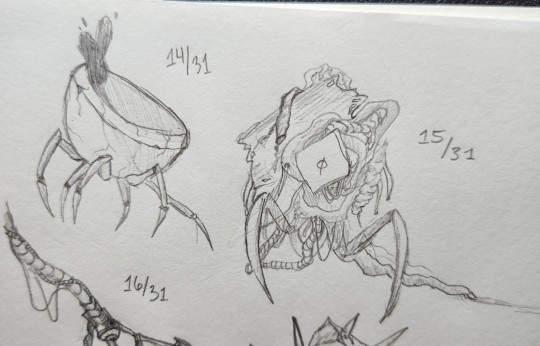
14: Along the lines of tome lackeys, mites, and other small scurrying Orthodoxy servants, this one was simply made to be a bowl, carrying ichor or other liquids to partake in holy rituals.
15: This wiry creature has wrapped itself in stinking, decaying piles of discarded gore from the Orthodoxy's compleation chambers, topping it all off with a pilfered faceplate. Now, it wanders the rare dark corners of the Basilica looking for more flesh to add to its hoard.
16: Combination survey instrument and grappling hook, this Progress Engine device is used for detaining unwanted intruders. It features a prominent eye in the center, with its optic nerve wrapping up along the tentacle "arm". Smaller nerve bundles connect the eyes on the three claws to the center.
17: It's not too clear what this soft and goopy creature actually is, as it's a shy, quaking thing that's cloistered itself in the toughest shell it can find and added spikes and teeth to scare off others from investigating. Unfortunately, the ichorous tear trails it leaves behind make it easy to track. The poor thing has anxiety.
18: A helpful tool assistant from the Quiet Furnace, complete with tiny arms to hand off supplies to busy artisans.
19: This skite was of plot relevance in the New Phyrexia campaign I DM. It sucks up oil through its syringe and processes it in its abdomen, before the bulbs on its body change color to indicate the oil's mana affinity. It's how a core-born Swarm PC learned that she was in fact of Gitaxian descent.
20: Like a proto-Dominus, this being coalesced as an avatar of faith... but not the kind the Orthodoxy likes. Despite being white-mana-aligned, it shows itself to be something of a free spirit, and represents the faith of Phyrexians in themselves. This is deeply inconvenient to the Orthodoxy.
69 notes
·
View notes
Text
day 6 of @augustofwhump : confused / spark / veins
"Rook, what are you doing? Take the shot!" Ben — or Albedo who looked like Ben — gestured frantically towards his doppëlganger.
"Shoot me?" The second Ben snapped back incredulously. His hands were held up placatingly. In one hand, he clutched the Omnitrix. "You're obviously the fake!"
"Both of you, be quiet!" Rook barked. His gaze snapped rapidly between the two of them. His grip on the Proto-Tool was steady, but he couldn't decide on a target. He longed to squeeze his eyes shut and have a moment of peace and quiet to think, but everything was all happening so fast.
All he knew was that Ben had sent out a distress signal in the dead of night, and Rook had caught up to him a couple of blocks from his house, chasing Albedo through the dead of night.
Except that Albedo looked exactly like Ben this time — down to his chestnut hair and brilliant green eyes. And one of them (Rook wasn't sure which) had wrestled the Omnitrix away from the other before Rook had ordered them to freeze.
So this was the worst possible situation for him to walk in on.
Read the rest on AO3.
Prompt Masterlist | ← previous // next →
tip me on Ko-fi
10 notes
·
View notes
Note
So anyways I remember Hamilton the American Musical existed
-the song You’ll be Back
Fits perfectly for Space Riders Angel and Proto
Like it is too perfect for those two
Oh my God, I just remembered my Hamilton phase way back in 2017- AHEM. That song? Is exactly them, down to the toxicity I imagine they have.
Worldwide!Angel in the Space Riders AU fleed the cult after a long time of not wanting to be there anymore. The final straw was an Hour of Joy where Angel had to take care of the planet's citizens from being hurt by the cultists, and after months of planning an escape, they did it to never come back. To me the Prototype in the Space Riders AU took this as both an offense and a direct hit to the heart (if he has one lmao), but he was always a bit possessive and controlling of our Angel. He's the kind of partner who would demand to know where you have been if he thinks something is strange, except you just did the same stuff you always do.
I stand for toxic yaoyuri and I WILL say that Space Riders Prototype thought of Angel as both his property and his tool. They were his right-hand, his greatest weapon against his enemies, his wonderful achievement. This Angel willingly let the Prototype experiment on them, which is part of the reason why they are SO good at combat in this AU, and also why they sometimes spawn a set of woobly arms on their back. Kind of like a trophy wife, depending on how you see it! Angel fleeing and using everything Proto achieve against him... Yeah, that HURT.
AND. I'LL ADD MORE TO THIS: Even after 10 years, the Prototype still thinks he can win Angel back to his side via gifts, favors or promises that he'll toooootally be better this time around, just come back to him, he'll be good, he's not going to torture people for sport anymore, he promises! Which just screams how little Proto actually knows Angel but the idealized perfect weapon he made them be for him.
I say all of this, but Prototype genuinely cared for Angel. In his own twisted and awful way, but he did care, and deep down he still does. But he refuses to change, and will never do so. Meanwhile, Angel got through the worst of the worst mental-health wise the decade post fleeing, and nowadays has a pretty decent support system that will back them up whenever things get dire!
#poppy playtime#space riders au#ask tag#ppt prometheus#in this au i read their relationship as god too egocentric to properly care x devoted follower too angry to continue their way#prototype had the worst time of his life during that divorce lmao#he's just “nonononono it cant be im SURE i can get them back”#and worldwide! angel is just 'hey space riders! want to play a prank on the cult?'
19 notes
·
View notes
Note
[Femme!Dorothy anon, this is a long mess and I wish I could articulate myself better because your thiughts are so interesting] yes exactly. Dorothy doesn't want to be associated with anything masculine, and she genuinely is not masculine. She wears the occasional tie and is straightforward and that's it. She is in no way masc in style or behaviour other than being tall with a deep voice. In fact she's very feminine, her style is entirely conventionally on trend femme as a younger woman and as an older woman she is still clearly feminine just not trendily so (her silhouettes are from older decades and her overall style is very unique for the time yet today looks almost proto Boho in certain respects- imagine a modern substitute arts teacher in a getup of hers.). Why it changed is something you nailed, the divorce hit her self esteem hard and I think facing the reality of that plus how she's treated in general drove her from her ideal style, she gets actively laughed at and mocked when she dresses up. So she's retreated to a compromise, a safe style that she feels comfortable in. I can't articulate my thoughts on the change in her whenever she feels nice in a glitzy gown but I know you'll see where I'm trying to go and how important those glimpses are. And to go back to behaviour, this is why I was actually thinking exactly of the scenario you brought up with the strap. She's a feminine woman who has spent most of her life not being seen as either of those things (and then having both tied to a teenaged pregnancy and marriage which is another depressing complication, her femininity and womanhood are by association denigrated as bad choices, moral failings to be redeemed by being a good mother and wife. what does it mean when Stan cheated on her, in this context?). Dorothy wants to be treated as a desirable woman, a lady, and that goes further than wanting to be seen as pretty in a dress. It's also why I think Rose would understand her far easier than Blanche, why I think Blanche would actually trigger her at some point, because Blanche blatantly sees Dorothy as a masculine figure. She puts Dorothy in a protector role, at times almost desexualizes her because of how she's masculinized her. I don't say this as hate, I love Blanche, but Blanche comes from such a specific and different world to the others and its not out of hate that she does it either, it's simply how Dorothy currently fits into her understanding of the world with the tools she's been given. That's really a whole other topic and I don't want to just shove a whole thesis at you that you might not agree with so back to the original point. Yeah, Dorothy wouldn't in a million years want to wear a strap or have a partner assume she wants to lead/top/penetrate. It would be so deeply, deeply humiliating to her in that context and the opposite of healing. You portrayed the exact opposite of this perfectly in your recent fic, you get what her fantasy would be. And I've vomited so many half formed thoughts at you I'm going to stop talking now. The only thing I want to bring up before I shut up is when they're in the Rusty Anchor bathroom because it kills me everytime on so many levels, seeing Blanche wrestle with actually seeing Dorothy as a beautiful feminine woman, how Dorothy clearly understands how Blanche usually sees her, and Dorothy saying she's jealous of Blanche every day of her life because God, that scene is practically this conversation we're having distilled with how the world sees Dorothy and how much pain that causes her. [This message is all over the place and so long. Please feel free to delete it or only quote little parts. It boils down to me thinking you're so right with your headcanons and meta.]
oh anon 🥹🥹🥹 hand in marriage asap because you just get me - oh my god, how could I ever delete or ignore an ask like this !!!!! I absolutely live for your thoughts always (I am in love, seriously, where do I even begin?)
Honestly - and this might be insane so hear me out - would it be too crazy to say that I think those few times when Dorothy does wear elements of a “masculine” outfit, it could possibly be tied back to her own internal struggle with how she presents herself & how she’s perceived? Like, she thinks that maybe the bullying will quit if she gives in and embraces it, if she takes it back and tries to make it something she’s in control of, to try and enjoy something she feels so deeply uncomfortable with (story of her life tbh) because maybe she’ll be able to drown it out then???? are we seeing the vision … just a little thought that came up after reading that first bit, I like angst a normal amount. I feel like there’s definitely a shift away from that “masc energy” as the show goes on but maybe I’m nuts - of course it could have been for many different reasons !!! But I do think it’s mostly a show of growth & shedding those insecurities / stereotypes / etc.
YES !!!!!!!!!! oh my god dorothy fits the 1920s silhouette sooooo soso well & I think that’s what she would say she gravitates toward if asked (on the surface of course. We know by now that the layers & hiding herself is a result of her past and the constant bullying - I do believe that she may also just genuinely find comfort in dressing this way on some level, I don’t think it’s all negative, but it is definitely rooted in insecurity. The fact that she isn’t the bitter type, going on and on about the body she used to have & how she used to look, is kind of shocking to me ? But also a very good example of her gentle nature!!!!! she’s a lot more sensitive and “submissive” than she lets on imo. Very very gentle soul, she is not what she makes people think she is and it’s so devastating to watch her never let that go in canon because we all know she never will.)
Oh my god exactly exactly exactly — like a lady !!!! I’m so glad you brought up Blanche here (and to the blanche enthusiasts, I’m sorry in advance, look away…) because, listen. I have and will always have a problem with the way blanche literally bully’s her constantly & also ropes rose into it a lot ??? like, does dorothy fire back at her just as harshly, yes. Is it (playfully) deserved on both sides sometimes, yes. But holy hell - it seems like every time blanche fires an insult at Dorothy it gets her right in that delicate place because she always puts up her walls so quickly, like she’s genuinely being attacked. And especially having comments like those come from someone like Blanche - the absolute opposite of everything Dorothy has ever been told is wrong with her. Can you even begin to imagine? This has been talked about a few times in the fandom but it’s a subject that makes me especially upset. Blanche is just so unreasonably harsh. I don’t blame Dorothy for some of the things she says to her sometimes I’m sorry 😭🤚🏻. That ep where they were sitting a the table talking about what they’d say at each others eulogy’s , after Blanche said she always felt safe with Dorothy in the house? Yeah, I dont blame her for throwing out that last comment, I would’ve too. Like wow, okay… ( for the record dorothy is not like exempt from also being nasty sometimes, she’s made some insane comments as well 😭)
Blanche most definitely triggers her, many many times we see it!!! It’s so heartbreaking and I could write an essay on the whole subject. And she HAS to be aware of how severe Dorothy’s insecurities are, Blanche is far from oblivious. She’s not stupid, the whole thing is kind of sick. Petition to stop beating Dorothy into the ground please ??????????? Holy hell ???? I absolutely 100% agree with you anon and feel very strongly about the subject. Of the four of them Dorothy gets it the worst idc - it’s sooooooo heartbreaking because she’s the last of them that can handle it, deep down. Yet another topic I could talk about for hours!!!!
I have manyyyyyyyyyyy many things to say on Dorothy’s insecurities playing a massive role in how she views & feels about sex but I’ll save them for my side account, for now know that you are SO correct anon - it absolutely would be humiliating for her (incredible choice of words btw - holy that was so spot on) and would most definitely end in tears. I’ve brought it up five million times now & I promise I’ll shut up until it’s actually published but this is expanded on in the second chapter of that same fic !! Promise to actually post it soon and stop teasing it every other post haha
#anon…. please never stop sending me your thoughts you have no idea how much I enjoy them#seriously. oh my god you are a genius - you see the vision !!!!!!!#thank you so much I will be thinking about this (you’ve inspired me to get back to writing 🫡 hopefully I can finish & edit & maybe post#tonight !!!)#also anon - if you don’t already have an account in the fandom (& if you’re comfy obvs) I implore you to come join us!!! I’m obsessed with y#your thoughts !!!!!!!#dorothy zbornak#the golden girls#asks
7 notes
·
View notes